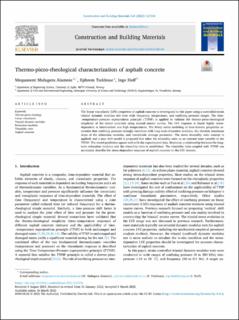| dc.contributor.author | Alamnie, Mequanent Mulugeta | |
| dc.contributor.author | Taddesse, Ephrem | |
| dc.contributor.author | Hoff, Inge | |
| dc.date.accessioned | 2023-01-31T10:16:29Z | |
| dc.date.available | 2023-01-31T10:16:29Z | |
| dc.date.created | 2022-03-16T10:11:22Z | |
| dc.date.issued | 2022 | |
| dc.identifier.citation | Alamnie, M. M., Taddesse, E. & Hoff, I. (2022). Thermo-piezo-rheological characterization of asphalt concrete. Construction and Building Materials, 329: 127106. | en_US |
| dc.identifier.issn | 1879-0526 | |
| dc.identifier.uri | https://hdl.handle.net/11250/3047324 | |
| dc.description.abstract | The linear viscoelastic (LVE) properties of asphalt concrete is investigated in this paper using a controlled-strain triaxial dynamic modulus test over wide frequency, temperature, and confining pressure ranges. The time–temperature-pressure superposition principle (TTPSP) is applied to validate the thermo-piezo-rheological simplicity of the tested materials using triaxial master curves. The LVE response is found highly stress-dependent at intermediate and high temperatures. The Prony series modeling of time-domain properties ascertains that confining pressure strongly correlates with long-term relaxation modulus, the absolute maximum slope of the relaxation modulus, and viscoelastic damage parameter. The stress triaxiality ratio concept is applied, and a new shift model is proposed that takes the triaxiality ratio as an internal state variable in the TTPSP. The model prediction agrees well with the experimental data. Moreover, a relationship between the long-term relaxation modulus and the triaxiality ratio is established. The triaxiality ratio coupled with TTPSP can accurately describe the stress-dependent response of asphalt concrete in the LVE domain. | en_US |
| dc.language.iso | eng | en_US |
| dc.publisher | Elsevier | en_US |
| dc.rights | Navngivelse 4.0 Internasjonal | * |
| dc.rights.uri | http://creativecommons.org/licenses/by/4.0/deed.no | * |
| dc.title | Thermo-piezo-rheological characterization of asphalt concrete | en_US |
| dc.type | Journal article | en_US |
| dc.type | Peer reviewed | en_US |
| dc.description.version | publishedVersion | en_US |
| dc.rights.holder | © 2022 The Author(s) | en_US |
| dc.subject.nsi | VDP::Teknologi: 500 | en_US |
| dc.source.pagenumber | 11 | en_US |
| dc.source.volume | 329 | en_US |
| dc.source.journal | Construction and Building Materials | en_US |
| dc.identifier.doi | https://doi.org/10.1016/j.conbuildmat.2022.127106 | |
| dc.identifier.cristin | 2010129 | |
| dc.description.localcode | Paid open access | en_US |
| dc.source.articlenumber | 127106 | en_US |
| cristin.qualitycode | 2 | |

